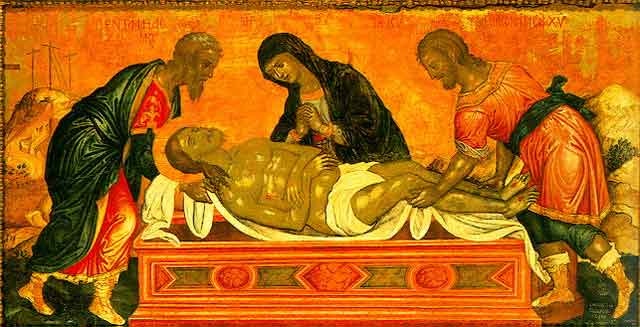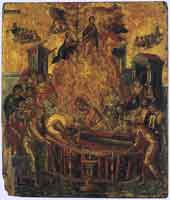.

Icon painted by Emmanuel Tzanes Bounialis, a representative of the Cretan School during the 17th century (Paul and Alexandra Canellopoulos Museum, Athens, Greece).
The term Cretan School is used, in order to describe an important school of painting, which flourished during the sixteenth and seventeenth century while Crete was under Venetian possession and whose representatives developed a particular style of iconography under the infuence of both Eastern and Westrern artistic traditions and movements.
During the sixteenth century around two hundred painters were active only in Candia (the Venetian name of Chandax, present day Herakleion), and had organized guilds, based on the Italian model.[1] The blending of the Eastern and the Western traditions, and a relaxed interchange between Greek Orthodox and Roman Catholic rites led to the "Cretan Renaissance", a golden period for the arts on the island. Literature and iconography were flourishing; there were numerous workshops, where prominent Cretan iconographers created their works. Some of these painters chose to follow the post-byzantine tradition of Constantinople, while others were influenced by the masters of the Venetian Renaissance, such as Giovanni Bellini and Titian.[2] Works of these masters or their copies were in monasteries and churches of the island, while works of the Flemish painters decorated the Catholic churches of Candia or were to be found in the private collections of rich Venetians and Greeks.[1]

The icon is signed by Michael Damaskenos and dates from the 16th century (Paul and Alexandra Canellopoulos Museum, Athens, Greece).
Art historians discern two main styles in painting: the maniera greca (alla greca, in line with the Byzantine idiom) and the maniera latina (alla latina, in accordance with Western techniques), which artists knew and utilized according to the circumstances; as a result some kind of "eclecticism" appeared.[3] Indeed, sometimes both styles could be found in the same icon, the one right next to the other.[1] The fame of the most prominent Cretan painters spread throughout Greece, the Mediterranean and Europe. In the beginning of the 16th century the Cretan artists had more commissions and their works were avidly sought, since they had started to use new motives and to adjust their iconography to the new trends of their era. The most famous Cretan artists were Theophanis Strelitzas (Θεοφάνης Στρελίτζας), Michael Damaskenos (Μιχαήλ Δαμασκηνός) and Georgios Klontzas (Γεώργιος Κλόντζας).[2] The intellectual and artistic personality of the young El Greco was also formed in this artistic environment. In 1563, at the age of twenty-two, El Greco was described in a document as a "master" ("maestro Domenigo"), meaning he was already officially practising the profession of painting.[4]
During the second half of the sixteenth century, many Cretan artists went to Venice, in the hope of gaining commissions and recognition. Unlike El Greco, the other Cretan painters who moved there did not substantially alter their styles or working methods. They simply incorporated more Italian motifs into a consistent Byzantine framework. Jonathan Brown provides a perceptive analysis of the ways that El Greco distinguished himself from other Cretan artists active in Venice, while Richard G. Mann argues that "none of these painters accepted Renaissance ideas about the relevance of change to the creation of art works".[5]
Prominent representatives of the Cretan School during the 17th century were Father Emmanuel Tzanes (Εμμανουήλ Τζάνες) and Theodoros Poulakis (Θεόδωρος Πουλάκης). The Cretan iconographers continued to flourish, until the Ottoman Turks took possession of the island in 1669.[6]

The Dormition of the Virgin (before 1567, tempera and gold on panel, 61,4 x 45 cm, Holy Cathedral of the Dormition of the Virgin, Hermoupolis, Syros) was probably created near the end of El Greco's Cretan period. The painting combines post-Byzantine and Italian mannerist stylistic and iconographic elements, and incorporates stylistic elements of the Cretan School.
Citations
- ^ a b c M. Lambraki-Plaka, El Greco-The Greek, 40-41
- ^ a b M. Tazartes, El Greco, 23-24
- ^ M. Lambraki-Plaka, El Greco-The Greek, 40-41
- * M. Tazartes, El Greco, 23-24
- ^ N.M. Panayotakis, The Cretan Period of Doménicos, 29
- ^ J. Brown, El Greco and Toledo, 76-78
- * R.G. Mann, Tradition and Originality in El Greco's Work, 88
- ^ X. Papaefthimiou, Popular Aspects of the Greek Iconography
References
- Brown, Jonathan (1982). “El Greco and Toledo”, El Greco of Toledo (catalogue). Little Brown. ASIN B-000H4-58C-Y.
- Lambraki-Plaka, Marina (1999). El Greco-The Greek. Kastaniotis. ISBN 9-60032-544-8.
- Mann, Richard G. (2002). "Tradition and Originality in El Greco's Work". "Journal of the Rocky Mountain" 23: 83-110.
- Panayotakis, Nikolaos M. (1986). “"The Cretan Period of the Life of Doménicos Theotocópoulos”, Festschrift In Honor Of Nikos Svoronos, Volume B. Crete University Press.
| Ancient Greece
Science, Technology , Medicine , Warfare, , Biographies , Life , Cities/Places/Maps , Arts , Literature , Philosophy ,Olympics, Mythology , History , Images Medieval Greece / Byzantine Empire Science, Technology, Arts, , Warfare , Literature, Biographies, Icons, History Modern Greece Cities, Islands, Regions, Fauna/Flora ,Biographies , History , Warfare, Science/Technology, Literature, Music , Arts , Film/Actors , Sport , Fashion --- |

